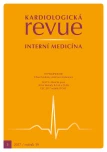What should not be done and why – cardiovascular prevention in the light of the latest recommendations
Authors:
M. Šatný
Authors‘ workplace:
III. interní klinika – klinika endokrinologie a metabolismu, 1. LF UK a VFN v Praze
Published in:
Kardiol Rev Int Med 2017, 19(3): 165-167
Overview
Last guidelines for the management of dyslipidaemia show us a new concept of rationalization of the diagnostic process, treatment and follow-up of our patients. In the new guidelines there is much more discussion about what should not be done and why. They mention a lot of particular steps which we should avoid, because they bring no benefit in the light of the latest studies. Let’s go through the whole process chronologically. According to the new guidelines we should not use the SCORE system for stratification of cardiovascular risk in patients younger than 40 years of age, in those with diabetes, chronic kidney disease or familial hypercholesterolemia. As for dyslipidaemia treatment, statins are still the drug of choice, also in the case of mixed dyslipidemia. Fenofibrate can be added to a statin when triglyceride levels exceed 2.3 mmol/L in high-risk patients. There are several groups of patients in whom statin therapy should be avoided, e. g. patients with heart failure without other indications, patients with aortic stenosis with coronary artery disease, autoimmune diseases, dialysis-dependent CKD without other cardiovascular disease. Treatment should be adequately monitored, over-monitoring and treatment interruptions should be avoided. Treatment goals continue to be the same – primary goal is LDL cholesterol, secondary goal non-HDL cholesterol – but not HDL cholesterol.
Keywords:
guidelines – dyslipidaemia – diagnostics – treatment – dispensarisation – creatine kinase – alanine transferase
Sources
1. Catapano AL, Graham I, De Backer G et al. 2016 ESC/ EAS Guidelines for the management of dyslipidaemias. Eur Heart J 2016; 37(39): 2999– 3058. doi: 10.1093/ eurheartj/ ehw272.
Labels
Paediatric cardiology Internal medicine Cardiac surgery CardiologyArticle was published in
Cardiology Review

2017 Issue 3
Most read in this issue
- Cardiovascular risk stratification and new serum lipid target levels
- SGLT2 inhibitors (gliflozins) antidiabetics, antihypertensives or drugs for heart failure?
- Statin intolerance – finding practical solutions
- Infective Endocarditis
